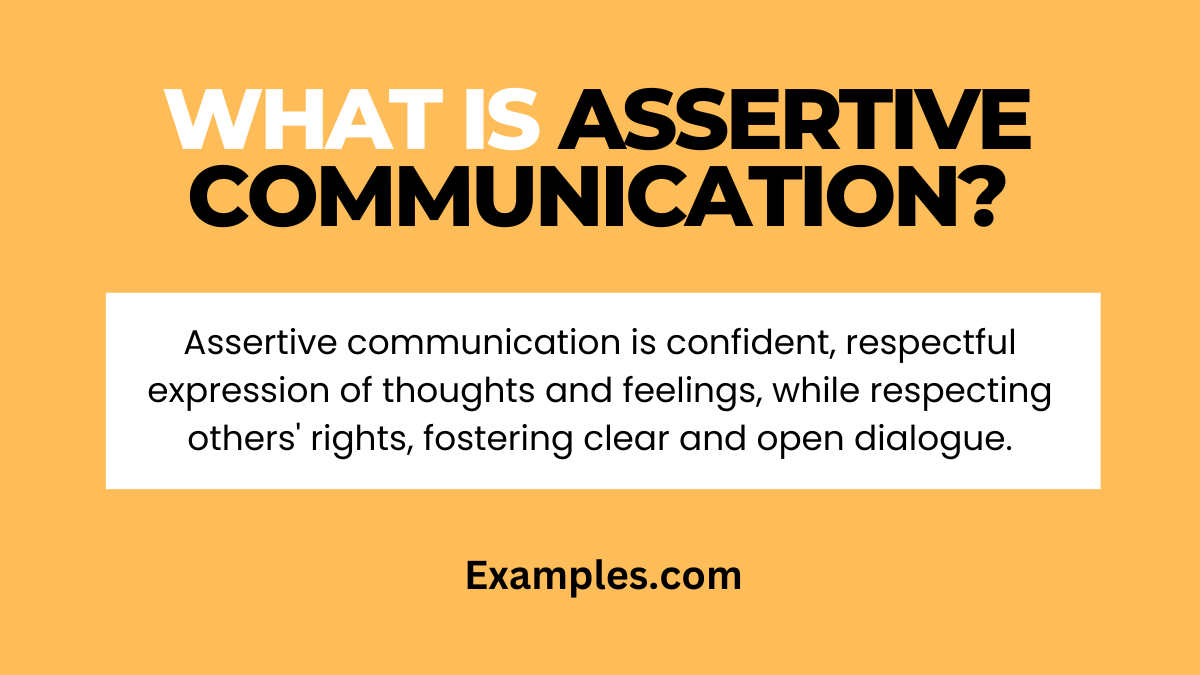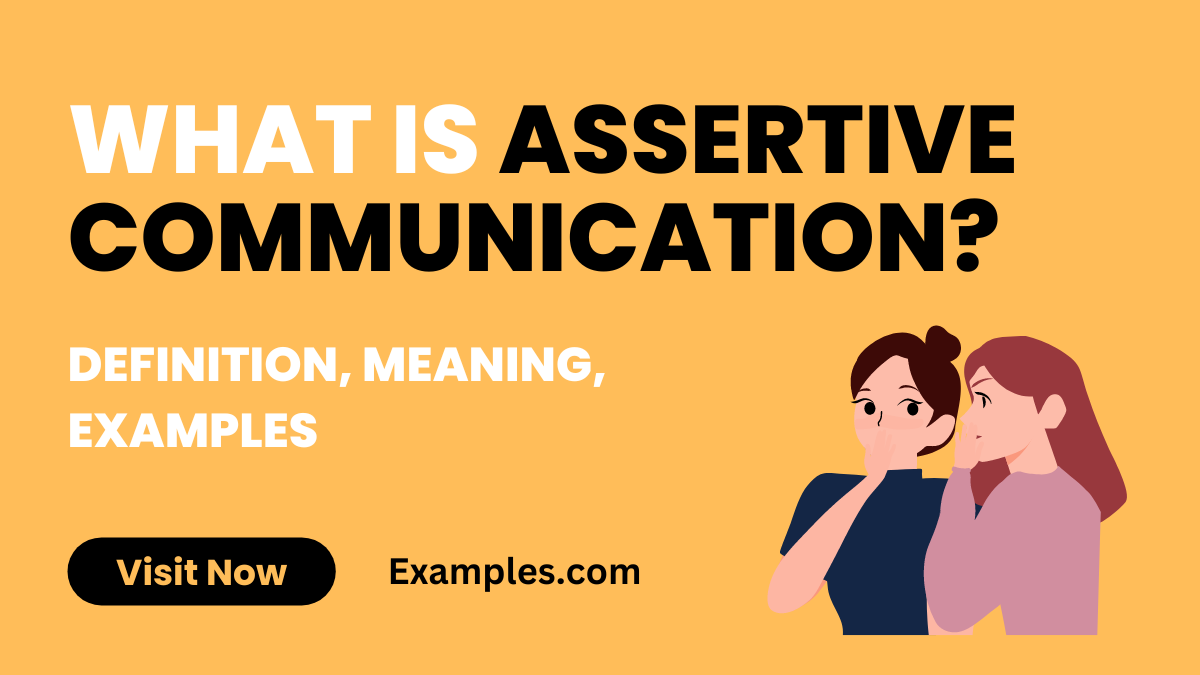What is Assertive Communication? – Definition, Meaning, Examples
Assertive communication stands as a vital skill in fostering respectful, clear, and effective personal and professional interactions. This comprehensive guide delves into the nuances of assertive communication, offering insights and real-world examples. By mastering this skill, individuals can express themselves confidently and respectfully, ensuring their voice is heard while maintaining positive relationships. Embracing assertive communication enhances dialogue, promotes mutual understanding, and empowers individuals in various social contexts.
What is Assertive Communication? – Definition

Assertive communication is a style of expressing one’s thoughts and feelings in a clear, honest, and respectful way. It involves standing up for your own rights while also respecting the rights of others. Unlike passive communication, which avoids expressing thoughts directly, or aggressive communication, which often disregards others’ feelings, assertiveness strikes a balance. It allows for open, two-way conversations where both parties feel heard and valued. This communication style is key in building healthy relationships and effectively managing conflicts.
Assertive Communication in Nursing
In nursing, assertive communication is vital for effective patient care. It involves clear and respectful expression of concerns, collaboration with colleagues, and advocating for patients’ well-being. Nurses use this skill to ensure quality healthcare delivery and promote patient safety.
Assertive Communication at Workplace
Assertive communication in the workplace fosters a positive environment. It includes expressing ideas confidently, addressing conflicts respectfully, and actively listening to colleagues. This skill enhances teamwork, reduces misunderstandings, and contributes to a productive and harmonious work setting.
Assertive Communication for Teens
Assertive Communication for Teens benefit from assertive communication to express themselves confidently and respectfully. It aids in dealing with peer pressure, setting boundaries, and building self-esteem. Learning this skill empowers teenagers to navigate social challenges and make informed choices.
Assertive Communication in Psychology
In psychology, assertive communication is a therapeutic tool. Psychologists use it to help clients express emotions, assert their needs, and establish boundaries. It creates a safe space for open dialogue, promoting emotional well-being and healthier relationships.
Assertive Communication Skills
Assertive communication skills encompass the ability to express thoughts and feelings clearly, assertively say “no” when necessary, and actively listen to others. These skills are crucial in personal and professional contexts, enhancing self-confidence and fostering healthy relationships.
- Active Listening in Assertive Communication
- Clear Expression in Assertive Communication
- I Statements in Assertive Communication
- Respectful Tone in Assertive Communication
- Empathy in Assertive Communication
- Body Language in Assertive Communication
- Emotional Control in Assertive Communication
- Constructive Feedback in Assertive Communication
- Setting Boundaries in Assertive Communication
- Conflict Resolution in Assertive Communication
Elements of Assertive Communication
Assertive communication comprises several essential elements, including clear and direct expression of thoughts and feelings, active listening to others, respect for boundaries, and the ability to express needs and preferences. These elements collectively contribute to effective and respectful communication.
Types of Assertive Communication
There are various types of assertive communication, each suited to different situations. These types include assertive requests, assertive responses to criticism, and assertive refusal of requests. Understanding and applying the appropriate type is crucial for effective communication and conflict resolution.
Assertive Communication Styles
Assertive communication can manifest in different styles, such as the “I” statements style, empathetic assertiveness, and constructive confrontation. Each style has its strengths and applications, allowing individuals to choose the most appropriate approach depending on the context and goals of the communication.
- Direct Communication in Assertive Communication
- Open and Honest Expression in Assertive Communication
- Non-Verbal Assertiveness in Assertive Communication
- Empathetic Listening in Assertive Communication
- Respectful Disagreement in Assertive Communication
- Solution-Oriented Approach in Assertive Communication
- Firm Boundary Setting in Assertive Communication
- Positive Affirmation in Assertive Communication
- Constructive Criticism in Assertive Communication
- Calm and Composed Response in Assertive Communication
Assertive Communication Techniques
Assertive communication techniques involve specific strategies for expressing oneself effectively and respectfully. These techniques include using “I” statements to express feelings, active listening, setting clear boundaries, and confidently stating one’s needs and opinions. They empower individuals to communicate assertively in various situations.
Characteristics of Assertive Communication
Characteristics of assertive communication include clear and direct expression of thoughts and feelings, active listening to others, respectful tone and body language, and the ability to maintain boundaries. Assertive communicators stand up for their rights while respecting the rights of others, leading to effective and respectful interactions.
- Clarity in Assertive Communication
- Honesty in Assertive Communication
- Respect in Assertive Communication
- Confidence in Assertive Communication
- Empathy in Assertive Communication
- Directness in Assertive Communication
- Firmness in Assertive Communication
- Openness in Assertive Communication
- Self-Control in Assertive Communication
- Consistency in Assertive Communication
Assertive communication offers numerous advantages and disadvantages, such as fostering healthy relationships, resolving conflicts constructively, enhancing self-esteem and resistance from others. To maximize the benefits, remember to use tips for assertive communication, including active listening, “I” statements, and respectful tone. Mastering this communication style empowers individuals to express themselves effectively, ensuring their voice is heard while maintaining respect for others.


